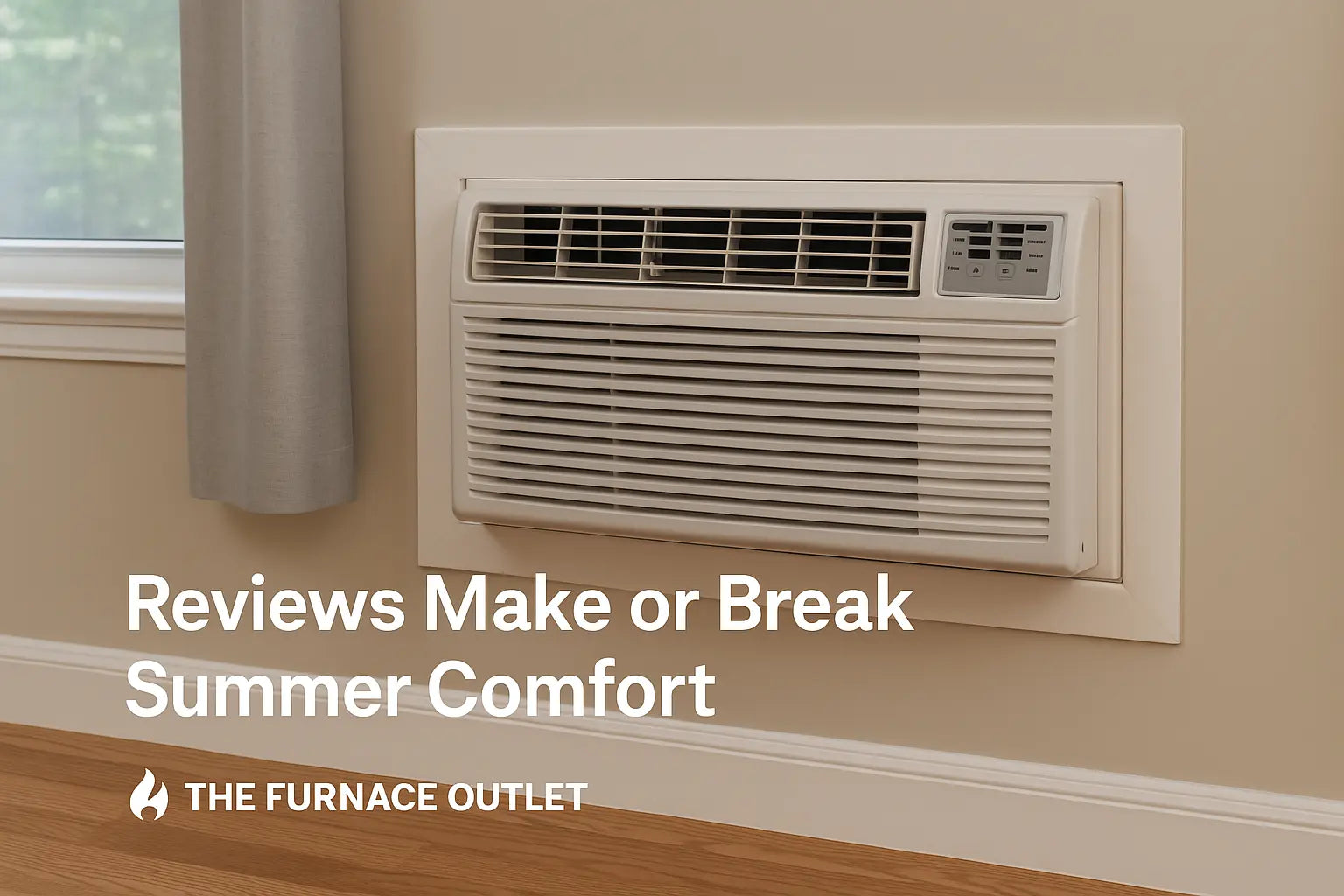Key Takeaways
-
Trust verified reviews — real buyers give reliable insights
-
Mid-star ratings = honest pros and cons
-
Watch for repeated complaints — they reveal real flaws
-
Pick reviews from similar climates
-
Check expert sources for full picture
Reviews Make or Break Summer Comfort
Imagine hitting “Buy Now” on a shiny new window AC, only to learn–from sweaty nights and sleepless groans–that dozens of owners said the same model wheezes in humid heat. In the U.S. alone, more than 5 million room air conditioners land in windows and walls each year, and roughly 90 % of shoppers read reviews before purchasing. But with studies estimating about 30 % of those reviews are fake, and Amazon blocking 250 million suspected fakes in 2023, sorting truth from noise is critical.
This guide shows, step-by-step, how to read customer feedback like an HVAC pro while still keeping the language simple enough for a middle-schooler. By the end you’ll know which voices to trust, which red flags to ditch, and how to link what you read to your own room size, climate, and budget.
Want real performance that outlasts fake reviews? Explore verified top-rated wall units.
Why Trust Matters: Sorting Real Voices from Noise
A single bad AC can cost more than lost sleep; it can spike summer bills and shorten compressor life. fake praise hides those risks. Look first for “Verified Purchase” tags—e-commerce sites confirm the buyer actually placed an order, so there’s skin in the game. Check the review date pattern: if hundreds pop up on the same day, the seller may have sent mass coupons in exchange for five stars. Experts also look for sensory words (“fan rattled like a loose bolt”) versus vague hype (“awesome!”).
No guessing games, shop units praised by real owners.
Spotting Verified Purchases and Other Credible Cues
Think of each review like a detective clue. Verified badges prove ownership, but credibility grows when the writer shares installation photos, ambient temperature, and room square footage. Those details let you compare apples to apples. Next, measure tone: honest reviewers often blend praise with minor nitpicks (“cools fast but filter door feels flimsy”). Finally, note any seller responses. Fast, helpful replies hint at solid after-sales support. When cues align, you can trust the verdict; when they clash, keep digging.
Need quick installation with no pro required? Try our DIY mini-splits.
Reading the Middle Ground: Mining 3-Star Gold
Why not just skim five-star raves? Because glowing praise may skip drawbacks. Three- and four-star posts usually list what works and what doesn’t, giving balanced insight. For example, several 4-star owners of an LG 12 000 BTU unit loved its quiet sleep mode but flagged a short power cord. Patterns like that help you budget for an extension kit before installation. Flip side: recurring 3-star notes on “ice buildup after two months” can signal a design flaw. Mining the middle ensures surprises stay pleasant.
Avoid surprises, shop balanced, well-reviewed options.
Pattern Hunting: Cooling Power, Noise, and Build Quality
Open ten tabs of reviews and scan for repeats. If “great cooling” shows up in desert states but “struggles past 90 °F” dominates humid-coast feedback, you’ve spotted a climate-related limit. Likewise, frequent gripes about “metallic rattle on high fan” indicate a vibration issue. To widen your view, compare models head-to-head in this window vs through-the-wall breakdown.
Patterns are powerful because they outvote one-off opinions and protect your wallet from hidden flaws.
Matching Reviews to Your Room, Climate, and Lifestyle
A Brooklyn studio and a Phoenix bungalow live different AC lives. Filter reviews by square footage, insulation level, and regional heat index. If your bedroom is 250 ft², a reviewer cooling 600 ft² may not be relevant. Similarly, a Maine user might praise whisper-quiet operation while never testing full-blast performance above 100 °F. For wall units, see the Complete Guide to Choosing the Right Through-the-Wall AC for BTU math and sleeve sizing.
Match lifestyle, too: night-shift workers need low fan noise; allergy sufferers prioritize washable filters. Aligning context with your own makes every star count.
Energy Efficiency & Longevity: Saving Dollars for Years
An AC that gulps electrons might cost more in one summer than a model with a higher CEER rating costs up-front. Reviews often mention energy bills and maintenance needs—gold when utility rates climb. Pay attention to comments after one or two summers; these flag coil corrosion, thermostat drift, or fan-motor failure. For hands-on maintenance tips, bookmark Choosing & Maintaining Your 12 000 BTU Window AC.
Units earning consistent praise for low bills and easy filter access usually outlive flashy budget models, making them cheaper long-term.
Beyond the Comments: Expert Tests and Pro Help
Customer stories are step one; lab numbers finish the puzzle. Sources like Consumer Reports measure cooling speed, noise in decibels, and standby wattage under controlled conditions. Pair those scores with detailed owner feedback for the full picture. The Furnace Outlet’s Overview of the Best Through-the-Wall ACs and its Goodman GSXN402410 review roundup bridge both worlds—testing data plus real-life quotes
When numbers and narratives agree, you can buy with confidence; when they clash, dig deeper or choose another model.
Want hotel-grade comfort at home? Check PTAC heat pump units.
FAQ: Your Quick-Fire Questions Answered
Q1. How many reviews should I read before trusting a rating?
Aim for a minimum of ten across different star levels. Consistency is more important than volume.
Q2. Do fake reviews always look the same?
No, but red flags include repeated phrasing, identical photos, and new accounts with only one review.
Q3. Are expert lab tests more reliable than customer feedback?
They’re different tools. Lab tests show controlled performance; owner stories reveal day-to-day quirks. Use both.
Q4. Is a high CEER rating worth the extra cost?
Usually yes—electricity savings often repay the premium within two or three summers.
Q5. Where can I find more pro tips?
Check The Furnace Outlet’s ever-growing HVAC Tips library for sizing charts, install guides, and seasonal checklists.







